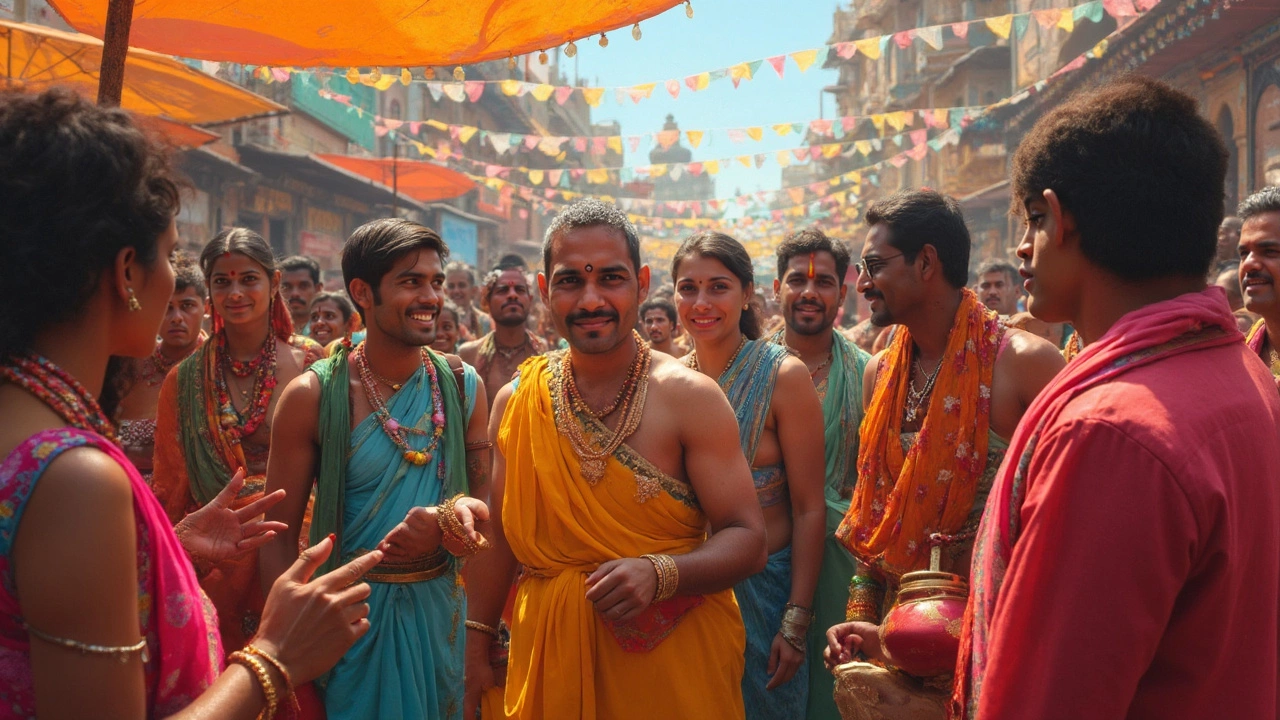So, you're curious about Christians wearing a bindi, huh? It's a pretty intriguing topic that stirs up a mix of culture, tradition, and personal choice. The bindi, that small dot some people wear on their forehead, isn't just about a pretty accessory; it carries a whole lot of meaning. But in this ever-connected world, is it okay for Christians to sport one without raising eyebrows?
The bindi's story started in ancient India, packed with religious and cultural symbolism. It was like a third eye, a reminder of wisdom and focus. Fast-forward to today's globalized culture, and it's become a fashion statement too. So, more people are curious about wearing it, including Christians who might love the style but are unsure about the cultural vibes they'll be sending.
It's easy to see why someone would be drawn to wearing a bindi. They're colorful, stylish, and add that little pop of uniqueness to an outfit. But it’s not all about looks. For many, it’s got ties to religious and cultural beliefs. And that's where things get a bit tricky. If you’re diving into cultural fashion, balancing appreciation and appropriation is key. Doing a little homework on its significance and how it's integrated into various cultures can make a big difference.
- Origins and Significance of the Bindi
- Cultural vs. Religious Usage
- Bindi as a Fashion Statement
- Christian Perspectives on Wearing Bindis
- Navigating Cultural Sensitivity
- Tips for Embracing Cultural Fashion
Origins and Significance of the Bindi
Alright, let’s start with where the bindi comes from. Its roots stretch way back into ancient India. Originally, it was a sacred symbol, rooted deeply in Hindu tradition. This little dot has been known as the 'third eye,' representing wisdom and spiritual insight. It's like a bridge between the material and spiritual worlds, which is pretty fascinating.
Historically, the bindi was tied to the practice of placing kumkum or sindoor on one's forehead during religious ceremonies. In many Indian cultures, it's not just about looks but about showing devotion and focus. A scholar once put it simply, saying:
The bindi on the forehead is a constant reminder to keep one's thoughts pure and focused on a higher purpose.
As time passed, the significance of the bindi shifted in many communities. What started as a religious symbol has also taken on cultural nuances. In particular, married Hindu women wear a red bindi as a sign of matrimony and prosperity. It’s a beautiful blend of culture and faith wrapped up in a tiny dot.
Now, as the world becomes more and more a melting pot of traditions, the bindi has found its place in global fashion too. People of various backgrounds, including Christians, are drawn to its aesthetic appeal and are curious about its roots. When wearing it as a fashion accessory, it’s always good to understand its history, so it’s more about appreciation than appropriation.
Whether it's about religious devotion or simply making a style statement, the bindi continues to be a significant part of Indian culture. Respecting its origins while embracing its modern flair is the way to go.
Cultural vs. Religious Usage
When it comes to the bindi, it's important to know that it straddles both cultural and religious lines. The line between fashion and faith is not always clear, and this is where things can get complicated for someone like a Christian who might be interested in wearing one.
Traditionally in India, the bindi is worn by Hindu women and is loaded with religious meaning. It's often seen as a symbol of marital status and is believed to be an exertion of spiritual protection over the wearer's wisdom and energy. But here's the kicker: it has also become a part of cultural norm in India that transcends religious boundaries.
However, in today's world, it's not just confined to religious or married women. The cool part is its evolution into a broader cultural icon that some people wear purely for fashion. Alyssa Milano, the American actress, once said,
"Fashion is something that you can have fun with, and cultures have always inspired trends worldwide."The bindi fits this idea, showing how something steeped in tradition can evolve over time.
But, wearing one as a fashion statement comes with the need to be mindful of cultural sensitivity. There have been instances of controversy over cultural appropriation, where people from outside the tradition might wear it without understanding or respecting its meanings. And that’s a big deal, especially in multicultural societies where understanding and respecting cultural differences matter a lot.
So, if Christians or anyone from outside Hindu culture want to embrace wearing a bindi, it’s helpful to approach it with respect and awareness. Here are a few tips to navigate this:
- Learn about the bindi's significance from reliable sources.
- Choose styles that are more common in fashion than in religious practices.
- Engage with people within the culture to better understand their perspectives.
While the intersection of culture and religion might feel like a tightrope sometimes, appreciating and respecting these aspects can make the process smoother.
Bindi as a Fashion Statement
The bindi has been on quite a journey from its roots in ancient India to runways and Instagram feeds around the world. Originally, it was closely tied to religious practices and cultural traditions, but today, it's also making a splash as a unique fashion accessory. So, what transformed this symbolic mark into a style icon?
In the 1990s, global pop culture started borrowing elements of Indian fashion, with celebrities donning bindis in music videos and on red carpets. This trend helped the bindi break out of its traditional mold. Now, many folks, regardless of their cultural background, wear it purely for its aesthetic appeal. It's not just about tradition anymore; it's a way to add a splash of color and creativity to any outfit.
Many people enjoy matching the color of their bindi to their outfit or even using it to make a bold contrast. The availability of bindis in various shapes, sizes, and colors has made it a versatile accessory for fashion enthusiasts. Plus, social media influencers often show their followers how to incorporate the bindi into modern styles, emphasizing its role as a bridge between cultural heritage and contemporary fashion.
But here's something to chew on: while using the bindi as a fashion statement, is it being culturally appreciated or appropriated? This is where awareness and respect come into play. If you're going to rock a bindi, it's a good idea to know its origins and significance. Talk to people who wear it traditionally and learn the story behind it. This isn't just about looking cool—it's about appreciating a rich cultural symbol without stepping on toes.
So, as you explore the fashion potential of the bindi, keep the balance between style and sensitivity. After all, fashion is not just about what you wear but also about how you understand and respect the stories behind those styles.

Christian Perspectives on Wearing Bindis
When it comes to Christians considering whether or not to wear a bindi, there’s a bit of a crossroads between culture and faith. At its heart, Christianity is diverse, with followers all over the globe bringing their own cultural flavors to the table. So, opinions can vary a lot when it comes to adopting cultural symbols like the bindi.
For many Christians, wearing a bindi might just be seen as a way to appreciate and engage with another culture. After all, Jesus Himself was all about compassion and understanding, right? So, if you're wearing it with genuine respect and aesthetic appreciation, some Christians would say that's in line with their faith. Now, this doesn't mean everyone thinks it’s always appropriate. Some Christians might worry that wearing religious symbols of another faith, even if the bindi is more cultural nowadays, could be confusing or even seen as disrespectful.
In practice, the Church doesn't have a one-size-fits-all stance on things like this. It's more about personal conviction and context. Many Christians who are part of multicultural communities often find they are more open to integrating various cultural aspects, as long as it doesn't clash with their own beliefs.
Here are a few tips for Christians who are considering wearing a bindi:
- Do your homework: Know why you're wearing it and respect its origins. It's always better to err on the side of cultural understanding.
- Ask local practitioners: If possible, talk to people within Hindu communities or those who regularly wear bindis. They can offer insights into what it means to them.
- Consider context: Think about where you’ll be wearing it. Will it be understood as cultural appreciation, or might it cause confusion?
A lot of it comes down to intention and awareness. Wearing a bindi thoughtfully could be a great way to express solidarity and appreciation for Indian culture, provided it’s done right.
Navigating Cultural Sensitivity
Alright, so you've got your eyes on wearing that stylish bindi. But here’s the catch: how do you pull it off without stepping on cultural toes? It's not just about looking good—it's about understanding where the line is between appreciating and appropriating culture.
The concept of cultural sensitivity revolves around respect and mindfulness. It's not just about “borrowing” from another culture. It’s about recognizing its roots and significance. When it comes to the bindi, this is particularly true since it's deeply embedded in Indian religious and cultural landscapes.
Amy Tan, an author known for exploring cultural themes, once said, "Believing that you can own the right to wear a cultural symbol without understanding its meaning is a kind of cultural hubris."
Before wearing a bindi, consider these steps to ensure you're being respectful:
- Research: Learn about the bindi’s historical and cultural contexts. This will give you insight into its significance and how it's perceived in different communities.
- Ask: If you have Indian friends or connection, have a conversation. They can offer personal insights into what the bindi means to them.
- Context Matters: Think about the setting where you plan to wear a bindi. Wearing it to an Indian wedding as a mode of participation is often welcomed, but sporting it as a random fashion accessory might not hold the same acceptance.
- Respect Feedback: Be open to feedback and willing to adjust. If someone from the culture tells you it’s not proper, take their advice seriously.
The bottom line is that respect doesn’t cost a dime but goes a long way in embracing cultural fashion without crossing boundaries. By taking the time to understand and respect the cultural relevance, you can enjoy the beauty of the bindi and connect with its rich history while also respecting those for whom it holds traditional value.
Tips for Embracing Cultural Fashion
Alright, so you're thinking about exploring cultural fashion, and why not? Mixing style with a touch of tradition can be awesome, but it's a good idea to tread carefully to ensure you're respectful and open-minded.
First off, do some homework. Learn about the origins and meanings behind the cultural pieces you’re eyeing. When you understand the significance, like that of the bindi, you can appreciate them for more than just their looks.
Next up, try talking to people from the culture you're interested in. If you have friends or acquaintances who can share their thoughts and stories, it can give you insights that Google just can't provide.
Here’s a pro tip: think about the context. Some cultural items have a special place in religious or ceremonial settings, like a bindi often does in Indian traditions. Just being aware of when and where you sport these pieces can go a long way in showing respect.
When you shop, look for authentic sources. Supporting artisans or communities directly can make a positive impact and ensure you get the genuine stuff. Plus, wearing something knowing who made it adds a story to your style.
So, in a nutshell, embracing cultural fashion is about mixing curiosity with respect. It's not just about looking good; it's about acknowledging and valuing the richness of the world's diverse cultures.



